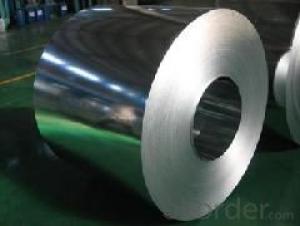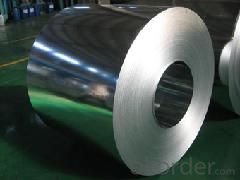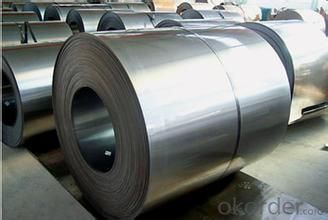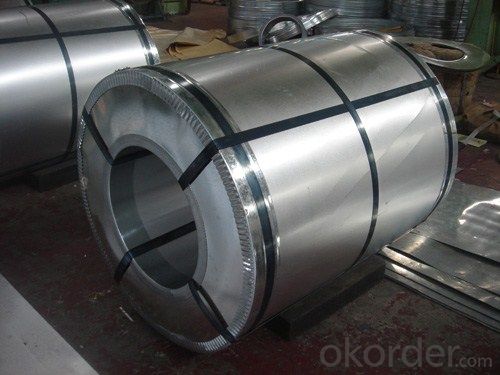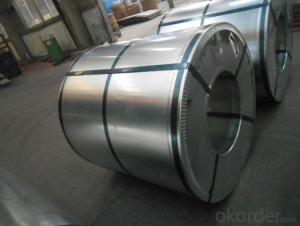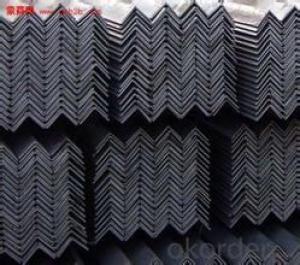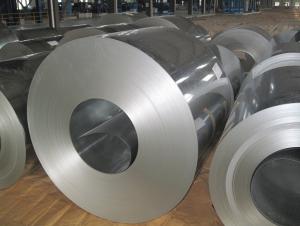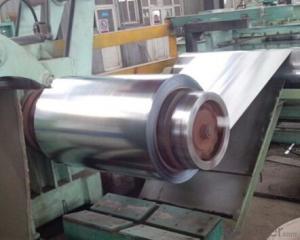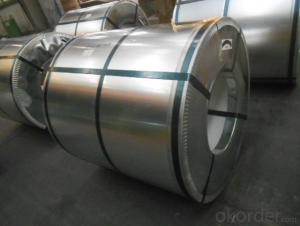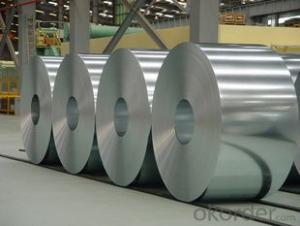Hot-Dip Galvanized Steel Coil with Good Price of China
- Loading Port:
- Shanghai
- Payment Terms:
- TT OR LC
- Min Order Qty:
- 50 m.t.
- Supply Capability:
- 10000 m.t./month
OKorder Service Pledge
OKorder Financial Service
You Might Also Like
1. Hot-Dip Galvanized Steel Coil Description:
Hot-dip galvanized steel coil are available with a pure zinc coating through the hot-dip galvanizing process. It offers the economy, strength and formability of steel combined with the corrosion resistance of zinc. The hot-dip process is the process by which steel gets coated in layers of zinc to protect against rust. It is especially useful for countless outdoor and industrial application.
2.Main Features of the Hot-Dip Galvanized Steel Coil:
• Excellent process capability
• Smooth and flat surface
• Workability, durability
• Excellent heat resistance performance
• High strength
• Good formability
• Good visual effect
3.Hot-Dip Galvanized Steel Coil Images
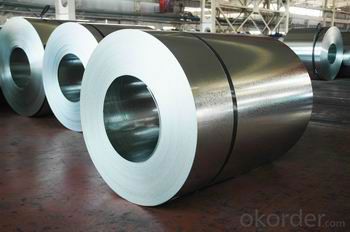
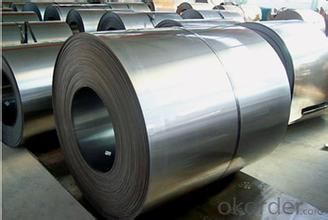
4.Hot-Dip Galvanized Steel Coil Specification
Standard: AISI, ASTM, BS, DIN, GB, JIS
Grade: SPCC, SPCD, Q195, DX51D
Thickness: 0.15-5.0mm
Model Number: coil
Type: Steel Coil
Technique: Cold Rolled
Surface Treatment: Galvanized
Application: Container Plate
Special Use: High-strength Steel Plate
Width: 600-1250mm
Length: depends
commodity: hot dipped galvanized steel coil
technique: cold rolled
thickness: 0.15-5.0mm
width: 600-1500mm
surface treatment: galvanized
zinc coating: 50-275g/m2
coil weight: 3-7 tons
coil ID: 508/610mm
spangle: zero spangle, regular spangle, small spangle, big spangle
payment term: by L/C or T/T
5.FAQ of Hot-Dip Galvanized Steel Coil
What’s the application of this product?
There are many applications for this product. For example, roofing, cladding, decking, tiles, sandwich walls, etc.
What’s the coating composition of Hot-Dip Galvanized Steel Coil?
The coating composition is 55% aluminium in weight ratio, 43.4% zinc, and 1.5% silicon, with excellent corrosion and heat resistance performance.
- Q: What is the yield strength of steel coils?
- The yield strength of steel coils can vary depending on the specific grade and composition of the steel. However, the typical yield strength of steel coils ranges from 300 to 600 megapascals (MPa).
- Q: How are steel coils used in the production of marine vessels?
- Due to their strength, durability, and versatility, steel coils find extensive use in the production of marine vessels. These coils, typically made of high-quality steel, possess the ability to withstand harsh marine environments and resist corrosion. The construction of the hull is one of the primary applications of steel coils in marine vessel production. Welding together steel coils that have been formed into plates creates the hull structure. The coils' strength ensures that the hull can endure the extreme forces and pressures encountered during vessel operation, including rough seas and heavy cargo loads. Furthermore, steel coils are employed in the production of various components and fittings within marine vessels. These coils can be shaped, cut, and formed into different parts like bulkheads, decks, and superstructures. The versatility of steel enables manufacturers to create intricate shapes and structures necessary for the efficient and safe functioning of a marine vessel. Moreover, steel coils are also used for fabricating pipes and tubing systems within marine vessels. These pipes are crucial for tasks such as fluid and fuel transportation, as well as ventilation throughout the vessel. The strength and corrosion resistance of steel coils ensure that these pipes can endure the high pressures and corrosive nature of marine environments. Additionally, steel coils are utilized in the production of marine vessel equipment like winches, cranes, and anchor systems. The components demand a material with high strength that can withstand heavy loads and constant use. Steel coils provide the necessary strength and durability to ensure the reliable performance of these vital equipment. In conclusion, steel coils play a crucial role in the production of marine vessels. Their strength, durability, and versatility make them an ideal material for constructing the hull, manufacturing various components, fabricating piping systems, and creating equipment. The use of steel coils guarantees the safety, efficiency, and longevity of marine vessels, enabling them to navigate the challenging conditions of the open seas.
- Q: What are the common applications of pre-painted steel coils?
- Pre-painted steel coils, also known as pre-coated steel coils or color coated steel coils, are widely used in various industries due to their versatility and durability. Some of the common applications of pre-painted steel coils include: 1. Construction: Pre-painted steel coils are extensively used in the construction industry for roofing, wall cladding, and building panels. The color options available in pre-painted steel coils allow architects and designers to create aesthetically pleasing structures. 2. Automotive: Pre-painted steel coils are used in the automotive industry for manufacturing car bodies, interior panels, and various other parts. The corrosion resistance and excellent finish provided by pre-painted steel coils make them a preferred choice in this industry. 3. Appliances: Many household appliances like refrigerators, washing machines, and air conditioners use pre-painted steel coils for their outer panels. The attractive colors and textures available in pre-painted steel coils help enhance the appearance of these appliances. 4. Electronics: Pre-painted steel coils are also used in the electronics industry for manufacturing cabinets and casings of electronic devices like computers, televisions, and audio systems. The protective coating on pre-painted steel coils helps protect the electronic components from environmental factors. 5. Furniture: Pre-painted steel coils find applications in the furniture industry for manufacturing cabinets, shelves, and other similar products. The wide range of colors and finishes available in pre-painted steel coils allows furniture manufacturers to create visually appealing and durable products. 6. Signage and Advertising: Pre-painted steel coils are commonly used in signage and advertising applications for manufacturing display boards, billboards, and signages. The vibrant colors and weather-resistant properties of pre-painted steel coils make them suitable for outdoor use. 7. Industrial Equipment: Pre-painted steel coils are utilized in the manufacturing of industrial equipment such as storage tanks, HVAC systems, and machinery components. The corrosion resistance and high strength of pre-painted steel coils make them suitable for these demanding applications. In summary, pre-painted steel coils have a wide range of applications in various industries such as construction, automotive, appliances, electronics, furniture, signage, and industrial equipment. Their durability, corrosion resistance, and aesthetic appeal make them a popular choice for manufacturers across different sectors.
- Q: How are steel coils used in the production of storage racks?
- Steel coils are used in the production of storage racks as they are cut and formed into different shapes and sizes to create the structural components of the racks. These coils are typically made from high-quality steel, providing strength and durability to the racks, making them suitable for storing heavy items.
- Q: I want to make an object out of stainless steel. Initially, I had planned to get it cut out of stainless steel sheet but several of the edges need to be rounded and I think it would be much cheaper to get it made of cast iron formed in a mold.Yet, it must be stainless steel. Can stainless steel be formed in a mold like iron can ... i.e. poured in liquid form into a mold and harden into shiny stainless steel?Would a regular foundry do this or do I need something special?Thanks.
- You have 2 options. Sand casting or investment casting. Stainless steel can be cast with either of these methods. In either case a model or pattern will have to be created. For sand casting the pattern is all that is needed to go to casting. For investment casting the pattern is used to make a wax casting, which is then coated with the investment. The wax is burned out and the metal is then poured into the cavity. If you are making just 1 or 2 pieces you can have waxes machined. This saves the intermediate step Depending on the size machining may still be your best option. Especially if you want just 1 part.
- Q: I'm buying a new set of steel plugs.I've heard things about streched ears and cold weather not being to good. do you think it would be bad to be wearing steal plugs?
- I have never had a problem with mine in any weather. They may feel a little tighter if you are cold, but if it is uncomfortable, just take 'em out!
- Q: Can steel coils be coated with zinc-nickel alloy?
- Yes, steel coils can be coated with zinc-nickel alloy.
- Q: How do steel coil manufacturers handle international shipping requirements?
- Steel coil manufacturers ensure that their products meet transportation standards and regulations for international shipping. This involves following specific packaging requirements, using appropriate containers, and securing the coils to prevent damage during transit. In order to meet international shipping requirements, manufacturers must also comply with customs regulations and documentation. They need to prepare accurate and complete paperwork, such as commercial invoices, packing lists, and bills of lading, to ensure smooth customs clearance procedures. Furthermore, steel coil manufacturers often collaborate with freight forwarders or shipping agents who specialize in international logistics. These professionals have extensive knowledge of shipping regulations, routes, and carriers, and can assist with arranging transportation, negotiating freight rates, and handling necessary paperwork. Manufacturers may also choose to use intermodal transportation, which involves utilizing multiple modes of transportation like trucks, trains, and ships. This allows for more efficient and cost-effective shipping, especially for long-distance or international shipments. Additionally, steel coil manufacturers may consider obtaining insurance coverage to protect their products during transit. Insurance provides financial compensation in case of any damage, loss, or delays during the shipping process. Overall, steel coil manufacturers handle international shipping requirements through careful planning, adherence to regulations, collaboration with logistics experts, and consideration of various transportation options. This ensures that their products reach international destinations safely, on time, and in compliance with all relevant regulations.
- Q: Are steel coils susceptible to damage during storage or transportation?
- Yes, steel coils are susceptible to damage during storage or transportation. Factors such as mishandling, improper stacking, exposure to moisture or extreme temperatures, and inadequate packaging can lead to dents, scratches, corrosion, and even deformation of the coils. Adequate precautions and secure packaging are necessary to minimize the risk of damage during storage or transportation.
- Q: What are the cost considerations when purchasing steel coils?
- When buying steel coils, there are several factors to consider regarding cost. To begin with, the price per unit of steel coil is a significant consideration. The cost of steel coils can vary depending on factors such as the type of steel, grade, thickness, width, and length. Higher-grade steel coils tend to be more expensive than lower-grade ones, and thicker or wider coils can also come at a higher cost. Another cost consideration is the quantity of steel coils required. Purchasing larger quantities often comes with volume discounts, so it is important to determine the necessary quantity and assess whether it is more cost-effective to buy in bulk or smaller batches based on demand and storage capacity. Transportation costs should also be taken into account. The weight and size of the coils can impact shipping costs, especially for long-distance transportation. Additionally, the distance between the supplier and the buyer can affect freight charges, so it is crucial to evaluate different shipping options and choose the most cost-effective method. Furthermore, it is essential to consider any additional costs associated with processing or customizing the steel coils. For example, if the coils need to be cut, leveled, or coated, these extra services can add to the overall cost. Obtaining quotes from different suppliers and comparing prices for these value-added services is important. Lastly, the overall quality and reliability of the steel coils must be taken into consideration. Although cheaper options may seem more cost-effective initially, they may end up costing more in the long run if they do not meet required standards or have a shorter lifespan. Choosing reputable suppliers with a history of delivering high-quality products is advisable to ensure that the investment in steel coils is worthwhile. In conclusion, the cost considerations when purchasing steel coils include the price per unit, quantity discounts, transportation costs, additional processing services, and the overall quality and reliability of the coils. Thoroughly evaluating these factors will help make an informed decision that balances cost-effectiveness with the desired quality and specifications of the steel coils.
Send your message to us
Hot-Dip Galvanized Steel Coil with Good Price of China
- Loading Port:
- Shanghai
- Payment Terms:
- TT OR LC
- Min Order Qty:
- 50 m.t.
- Supply Capability:
- 10000 m.t./month
OKorder Service Pledge
OKorder Financial Service
Similar products
Hot products
Hot Searches
Related keywords
